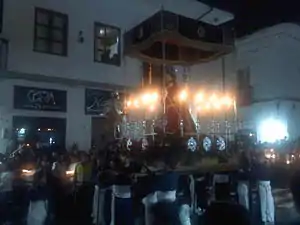Portal:Colombia
Colombia articles: History | Politics | Geography | Provinces | Economy | People | Culture | Café de Colombia | and much more...
The Colombia Portal
Colombia (/kəˈlʌmbiə/ ( Colombia has been home to many indigenous peoples and cultures since at least 12,000 BCE. The Spanish first landed in La Guajira in 1499, and by the mid-16th century they had colonized much of present-day Colombia, and established the New Kingdom of Granada, with Santa Fé de Bogotá as its capital. Independence from the Spanish Empire was achieved in 1819, with what is now Colombia emerging as the United Provinces of New Granada. The new polity experimented with federalism as the Granadine Confederation (1858) and then the United States of Colombia (1863), before becoming a republic—the current Republic of Colombia—in 1886. With the backing of the United States and France, Panama seceded from Colombia in 1903, resulting in Colombia's present borders. Beginning in the 1960s, the country has suffered from an asymmetric low-intensity armed conflict and political violence, both of which escalated in the 1990s. Since 2005, there has been significant improvement in security, stability and rule of law, as well as unprecedented economic growth and development. Colombia is recognized for its health system, being the best healthcare in the Americas according to The World Health Organization and 22nd on the planet, In 2022, 26 Colombian hospitals were among the 61 best in Latin America (42% total). Also in 2023, two Colombian hospitals were among the Top 75 of the world. Colombia is one of the world's seventeen megadiverse countries; it has the second-highest level of biodiversity in the world. Its territory encompasses Amazon rainforest, highlands, grasslands and deserts. It is the only country in South America with coastlines (and islands) along both the Atlantic and Pacific oceans. Colombia is a key member of major global and regional organizations including the UN, the WTO, the OECD, the OAS, the Pacific Alliance and the Andean Community; it is also a NATO Global Partner. Its diversified economy is the third-largest in South America, with macroeconomic stability and favorable long-term growth prospects. (Full article...) Selected article - The University of Valle (Spanish: Universidad del Valle), also called Univalle, is a public, departmental, coeducational, research university based primarily in the city of Cali, Valle del Cauca, Colombia. It is the largest higher education institution by student population in the southwest of the country, and the third in Colombia, with more than 30,000 students. The university was established by ordinance No. 12 of 1945, by the Departmental Assembly as the Industrial University of Valle del Cauca (Spanish: Universidad Industrial del Valle del Cauca), under the leadership of Tulio Ramírez Rojas and Severo Reyes Gamboa. The university has two campuses in Cali. The main one, known as University City of Melendez (Spanish: Ciudad Universitaria Meléndez, CUM), is located in the southern neighborhood of Melendez and hosts the faculties of Engineering, Humanities, Integrated Arts, Sciences, and Social Sciences and Economics, as well as the institutes of Education and Pedagogy, and Psychology. Its second one, located in the centric San Fernando neighborhood, hosts the faculties of Administration Sciences and Health. The university also has several satellite campuses across the department in the cities of Buenaventura, Buga, Caicedonia, Cartago, Palmira, Tuluá, Yumbo, and Zarzal, and one campus in the neighboring Cauca department in the city of Santander de Quilichao. The university offers education at technological, undergraduate and postgraduate levels, with 258 academic programs, which includes 65 master and medical specialties, and 8 doctorates. Also, it hosts an excellence research center, six research centers, three research institutes, and 204 research groups. (Full article...)Related portalsCategoriesCategory puzzle Select [►] to view subcategories
Colombia Colombia-related lists Buildings and structures in Colombia Colombian culture Economy of Colombia Education in Colombia Geography of Colombia Government of Colombia Health in Colombia History of Colombia Organisations based in Colombia Colombian people Politics of Colombia Society of Colombia Colombia stubs Selected biography -
Francisco de Asís León Bogislao de Greiff Haeusler (July 22, 1895 – July 11, 1976), was a Colombian poet known for his stylistic innovations and deliberately eclectic use of obscure lexicon. Best known simply as León de Greiff, he often used different pen names. The most popular were Leo le Gris and Gaspar Von Der Nacht. De Greiff was one of the founders of Los Panidas, a literary and artistic group established in 1915 in the city of Medellín. (Full article...)
Did you know (auto-generated)
General imagesThe following are images from various Colombia-related articles on Wikipedia.
Selected pictureLargest cities
TopicsNew articlesThis list was generated from these rules. Questions and feedback are always welcome! The search is being run daily with the most recent ~14 days of results. Note: Some articles may not be relevant to this project.
Rules | Match log | Results page (for watching) | Last updated: 2023-05-18 20:23 (UTC) Note: The list display can now be customized by each user. See List display personalization for details.
Wikiprojects
Things you can doIf you are interested in helping with this portal, please join WikiProject Colombia or one of its child projects:
Article requests
History (High priority)
Society
Scouting
People (Medium priority)
Physical geography
Media (Medium Priority)
Government and political affairs (High priority)
Wikipedia's portalsDiscover Wikipedia using portals
Sources | |||||||||||||||||||||||||||||||||||||||||||||||||||||||||||||||||||||||||||||||||||||||||||||||||||||||||||||||||||


.svg.png.webp)












.svg.png.webp)













%252C_1992%252C_Israel_Museum%252C_Jerusalem%252C_Israel.JPG.webp)











.svg.png.webp)
.svg.png.webp)